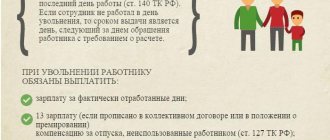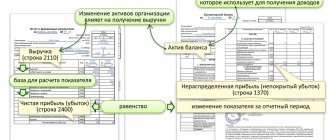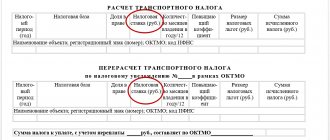The taxation system in the form of a single tax on imputed income (UTII) is one of the special tax regimes operating in the Russian Federation. The essence of this tax system is that when calculating UTII and paying it, taxpayers are guided by the amount of income imputed to them, which is established by Chapter 26.3 of the Tax Code of the Russian Federation (hereinafter referred to as the Tax Code of the Russian Federation). At the same time, the amount of income they actually received does not matter. Let's look at examples of calculating UTII and how to independently calculate the amount of a single tax.
Payers of UTII
The transition to paying a single tax is carried out by entrepreneurs voluntarily, subject to the following conditions:
- organizations and individual entrepreneurs registered as single tax payers with the tax authority within the prescribed period;
- the UTII taxation system has been introduced in the prescribed manner on the territory of the municipality where business activities are carried out;
- in the local regulatory legal act on UTII, among the types of business activities subject to this tax, the type of business activity being carried out is indicated.
The use of UTII exempts taxpayers from paying a number of taxes, in particular, organizations on UTII do not pay profit tax, VAT (except for “import”), and property tax. Individual entrepreneurs are exempt from paying personal income tax (on income received from activities subject to UTII), property tax for individuals (in relation to property used in activities subject to UTII), and VAT.
The list of types of activities in respect of which representative bodies have the right to decide on the introduction of UTII is indicated in paragraph 2 of Art. 346.26 Tax Code of the Russian Federation.
These include household and veterinary services, repair services, maintenance and washing of vehicles, retail trade, catering, distribution and (or) placement of outdoor advertising, etc.
Basic concepts about UTII
The single tax on imputed income (UTII) is not suitable for taxing legal entities or entrepreneurs. This is a system of taxation of specific types of business activities. For this reason, it is possible to combine this taxation system with either a simplified taxation system or a general one.
Let us note a number of features of this tax:
- UTII was mandatory until 2013. Starting on January 1, it became voluntary.
- Real income does not affect the final tax amount. Imputed income has the greatest impact. Therefore, in everyday life, UTII is also called “imputation”.
- UTII, unlike many other taxation regimes, is regulated not by a special law, but by a separate article in the Tax Code of the Russian Federation. Chapter 26.3 is separately devoted to UTII.
- UTII is often combined with the simplified simplified tax system, and one tax regime is chosen for one type of activity.
Procedure for calculating UTII
The calculation of the single tax is simple and is carried out on the basis of the standard indicators established by the Tax Code of the Russian Federation.
The tax base for calculating the single tax is imputed, i.e. potential income of the taxpayer UTII. Thus, the tax is calculated on the basis of imputed and not actually received income.
The tax base is calculated as the product of the basic profitability for a certain type of business activity, calculated for the tax period, and the value of the physical indicator characterizing this type of activity (clause 2 of Article 346.29 of the Tax Code of the Russian Federation).
In this case, the basic profitability is adjusted (decreased or increased) by coefficients K1 and K2 (clause 4 of Article 346.29 of the Tax Code of the Russian Federation).
The formula for calculating the tax base is as follows:
NB = DB x K1 x K2 x (FP1 + FP2 + FP3),
where NB is the tax base;
BD – basic profitability established for a specific type of business activity;
K1 – deflator coefficient;
K2 – correction factor;
FP1, FP2, FP3 – values of the physical indicator established for each type of activity in the first, second and third months of the quarter, respectively.
Physical indicators and basic UTII profitability
Next, let's take a closer look at the above indicators.
The values of basic profitability and physical indicator are determined for each specific type of business activity and approved by the norms of Article 346.29 of the Tax Code of the Russian Federation.
| Types of business activities | Physical indicators | Basic income per month (rubles) |
| 1 | 2 | 3 |
| Provision of household services | Number of employees, including individual entrepreneurs | 7 500 |
| Provision of veterinary services | Number of employees, including individual entrepreneurs | 7 500 |
| Providing repair, maintenance and washing services for motor vehicles | Number of employees, including individual entrepreneurs | 12 000 |
| Provision of services for the provision of temporary possession (for use) of parking spaces for motor vehicles, as well as for the storage of motor vehicles in paid parking lots | Total parking area (in square meters) | 50 |
| Provision of motor transport services for the transportation of goods | Number of vehicles used to transport goods | 6 000 |
| Provision of motor transport services for the transportation of passengers | Number of seats | 1 500 |
| Retail trade carried out through stationary retail chain facilities with trading floors | Sales area (in square meters) | 1 800 |
| Retail trade carried out through facilities of a stationary retail chain that do not have sales floors, as well as through facilities of a non-stationary retail chain, the area of the retail space in which does not exceed 5 square meters | Number of retail places | 9 000 |
| Retail trade carried out through stationary retail chain facilities that do not have trading floors, as well as through non-stationary retail chain facilities with a retail space exceeding 5 square meters | Area of retail space (in square meters) | 1 800 |
| Delivery and distribution retail trade | Number of employees, including individual entrepreneurs | 4 500 |
| Sales of goods using vending machines | Number of vending machines | 4 500 |
| Provision of public catering services through a public catering facility with a customer service hall | Area of the visitor service hall (in square meters) | 1 000 |
| Provision of public catering services through a public catering facility that does not have a customer service hall | Number of employees, including individual entrepreneurs | 4 500 |
| Distribution of outdoor advertising using advertising structures (except for advertising structures with automatic image changes and electronic displays) | Area intended for printing (in square meters) | 3 000 |
| Distribution of outdoor advertising using advertising structures with automatic image changes | Exposure surface area (in square meters) | 4 000 |
| Distribution of outdoor advertising using electronic signs | Light emitting surface area (in square meters) | 5 000 |
| Advertising using external and internal surfaces of vehicles | Number of vehicles used for advertising | 10 000 |
| Provision of temporary accommodation and accommodation services | Total area of premises for temporary accommodation and living (in square meters) | 1 000 |
| Provision of services for the transfer for temporary possession and (or) use of retail spaces located in facilities of a stationary retail chain that do not have trading floors, facilities of a non-stationary retail chain, as well as public catering facilities that do not have customer service halls, if the area of each they do not exceed 5 square meters | Number of trading places, non-stationary retail chain facilities, and public catering facilities transferred for temporary possession and (or) use | 6 000 |
| Provision of services for the transfer for temporary possession and (or) use of retail spaces located in facilities of a stationary retail chain that do not have trading floors, facilities of a non-stationary retail chain, as well as public catering facilities that do not have customer service halls, if the area of each exceeds 5 square meters | Area of a retail space, a non-stationary retail chain facility, or a public catering facility transferred for temporary possession and (or) use (in square meters) | 1 200 |
| Provision of services for the transfer of temporary possession and (or) use of land plots for the placement of stationary and non-stationary retail chain facilities, as well as public catering facilities, if the area of the land plot does not exceed 10 square meters | Number of land plots transferred for temporary possession and (or) use | 10 000 |
| Provision of services for the transfer of temporary possession and (or) use of land plots for the placement of stationary and non-stationary retail chain facilities, as well as public catering facilities, if the area of the land plot exceeds 10 square meters | Area of land transferred for temporary possession and (or) use (in square meters) | 1 000 |
What is a physical indicator
The second multiplier is the physical indicator of UTII (FP). This quantitative indicator is determined by the number of units generating income. Depending on the area of activity, this may be:
- number of vehicles carrying out transportation;
- number of square meters of advertising space;
- the number of workers performing any type of work;
- the total area of the premises for trade.
The full list of quantities that fall under the definition of a physical indicator is determined by the regulatory legal acts of the Russian Federation, including the Tax Code.
For most types of activities of individuals and legal entities, determining the financial status does not present a problem, but there are also difficult cases. If an entrepreneur works in several areas, only part of them is subject to UTII, and there are personnel who service everything - accounting, security, system administrator, etc. In this case, the required multiplier for such personnel for each area is calculated using the following methodology:
FP = (FPobs : FPenvd) x FPtax,
where each value means:
- FPobs - the total number of employees engaged in servicing all types of activities;
- FPenvd - the total number of employees employed in areas subject to UTII;
- FPtax - the number of employees employed in the calculated type of work.
The resulting figure is rounded up to the nearest whole number and added to the number of workers employed in this type of activity. This methodology is not included in the Tax Code of the Russian Federation, but is given in a letter from the Ministry of Finance of the Russian Federation.
Correction factors K1 and K2
Coefficients K1 and K2 allow you to adjust the basic profitability taking into account the influence of various external conditions (factors) on the amount of income received.
K1 is a deflator coefficient established by federal legislation for the calendar year. It is determined annually by the Ministry of Economic Development of Russia and published no later than November 20 of the year in which deflator coefficients are established. Its value corresponds to the indexation of consumer prices for various categories of goods and services.
UTII Coefficient K1 for 2022 is 1.915
K2 – adjustment coefficient of basic profitability, established by local legislation and taking into account the totality of features of doing business (list of goods, services, other features).
Calculation formula and payment of UTII
The single tax is calculated based on the results of the tax period using the following formula:
UTII = (Tax base * Tax rate) – Insurance Contributions.
The UTII rate is the same for all types of activities and all territories – 15%.
UTII taxpayers have the right to reduce the amount of tax calculated for the tax period by the amounts of payments (contributions) and benefits that were paid in favor of employees employed in those areas of the taxpayer’s activity for which a single tax is paid (Article 346.32 of the Tax Code of the Russian Federation).
If there are employees, it is possible to reduce the UTII tax on insurance premiums paid, but not more than 50 percent of the calculated tax amount.
Individual entrepreneurs working without employees (do not make payments or other remuneration to individuals) can reduce the amount of the single tax by the entire amount of fixed insurance contributions paid to the Pension Fund and Compulsory Medical Insurance in the reporting period (without applying the 50% limit). The resulting tax amount payable in this case cannot be less than 0.
The tax period for UTII is a quarter (Article 346.30 of the Tax Code of the Russian Federation).
This means that it is necessary to calculate and pay tax to the budget at the place of registration with the tax authority as a UTII taxpayer at the end of each quarter no later than the 25th day of the first month of the next tax period.
In the payment order for the transfer of tax, you must indicate the budget classification code (BCC).
Examples of calculations of the single tax on imputed income
Below are tax calculations for different types of activities.
An example of calculating UTII for the transportation of goods
The organization operates to provide motor transport services for the transportation of goods by 3 vehicles.
| Business activity code | 05 |
| Basic income per month (RUB) | 6000 |
| The value of the physical indicator (number of vehicles used to transport goods) | 3 |
| K1 coefficient for 2022 | 1,868 |
| K2 coefficient | 1,0 |
| Paid insurance premiums for employees | 27 000 |
Tax base for the month = DB*FP*K1*K2= 6,000 rubles. x 3 mash. x 1,868 x 1= 33,624 rub.
Tax base for the quarter = RUB 33,624. x 3 months = 100,872 rub.
UTII for the quarter = 100,872*15% = 15,131 rubles.
The amount of insurance premiums paid in the reporting period for employees engaged in business activities for which a single tax is paid amounted to 27,000 rubles. Thus, the calculated single tax can be reduced by insurance premiums paid, but not less than 50% of the total tax amount.
The amount of contributions by which UTII can be reduced for the quarter was 7,565 rubles. (RUB 15,131 x 50% < RUB 27,000).
Thus, the amount of UTII payable for the quarter will be 7,565 rubles. (RUB 15,131 – RUB 7,565).
If an organization registered as a UTII payer on the 10th day of the second month of the quarter, then the tax base for the quarter will be calculated as follows:
- 1 month of the quarter – 0 rub.;
- 2nd month of the quarter – 23,537 rubles. (RUB 6,000 x 3 cars x 1,868 x 1/30 days x 21 days);
- 3rd month of the quarter – RUB 33,624. (RUB 6,000 x 3 cars x 1,868 x 1/31 days x 31 days).
Calculation of imputed income (tax base)
Determine the tax base for the quarter depending on whether the organization used UTII throughout this period or not.
If the organization was a UTII payer for the entire quarter, then calculate the tax base using the formula:
| Tax base (imputed income) for the quarter | = | Basic profit per month | × | ( | The value of the physical indicator for the first month of the quarter | + | The value of the physical indicator for the second month of the quarter | + | The value of the physical indicator for the third month of the quarter | ) | × | K1 | × | K2 |
This procedure is provided for in paragraph 10 of Article 346.29 of the Tax Code of the Russian Federation.
If you switched to imputed tax in the middle of the quarter, then you need to calculate UTII starting from the date of registration as a single tax payer. First, calculate the tax base for the month in which the organization began to use UTII. Formula for calculating UTII:
| Tax base (imputed income) for the month in which UTII began to be applied | = | Basic profit per month | × | The value of the physical indicator ___________________________ | × | The actual number of days when activities were carried out using UTII, in the month in which the organization became a UTII payer | × | K1 | × | K2 |
| The number of calendar days in the month in which the organization became a UTII payer |
Next, determine the amount of imputed income for the remaining full months of the quarter. And add it to the amount of income received for the month in which UTII began to be applied. The result will be the tax base for the entire quarter (clause 10 of Article 346.29 of the Tax Code of the Russian Federation).
An important detail: if in one of the months the value of the physical indicator has changed, for example, the retail space of the hall has increased, then for this month take the new value to calculate the tax. Even if the change occurred in the middle of the month (clause 9 of Article 346.29 of the Tax Code of the Russian Federation).
Example of UTII calculation. The organization became a UTII payer in the middle of the quarter
The Alpha organization sells goods at retail through its own store with a sales area of 80 square meters. m. In the city where the organization operates, the use of UTII is provided for such activities. The UTII rate for retail trade is 15 percent. "Alpha" became a payer of UTII on January 28. In fact, in January the organization was a UTII payer for four days, in February and March for full months.
In 2016, the value of the deflator coefficient K1 is 1.798. Local authorities set the value of the correction factor K2 at 0.7.
The basic profitability for retail trade in the presence of trading floors is 1800 rubles/sq.m. m.
The imputed income for calculating UTII for January was: 1800 rubles/sq.m. m × 80 sq. m: 31 days. × 4 days × 0.7 × 1.798 = 23,386 rubles.
Imputed income for February–March was:
1800 rub./sq. m × (80 sq. m + 80 sq. m) × 0.7 × 1.798 = 362,477 rub.
Thus, the imputed income for calculating UTII for the first quarter is equal to 385,863 rubles. (RUB 23,386 + RUB 362,477).
UTII for the first quarter is equal to: 385,863 rubles. × 15% = 57,879 rub.
Now let’s talk about how to find out the amount of imputed income for the quarter in which the organization ceased its imputed activities. In this case, calculate the base from the first day of the quarter until the date of deregistration specified in the notification of the tax office. First, determine the tax base for the month in which the organization stopped using UTII using the formula:
| Tax base (imputed income) for the month in which UTII ceased to be used | = | Basic profit per month | × | The value of the physical indicator for the month in which the organization ceased to be a UTII payer | : | The number of calendar days in the month in which the organization ceased to be a UTII payer | × | The actual number of days of business activity using UTII in the month in which the organization ceased to be a UTII payer | × | K1 | × | K2 |
Next, determine the amount of imputed income for the remaining full months of the quarter. And add it to the amount of income received for the month in which UTII was no longer used. The result will be the tax base for the entire quarter (clause 10 of Article 346.29 of the Tax Code of the Russian Federation).
An example of calculating taxes on UTII. The organization ceased to be a UTII payer in the middle of the quarter
The Alpha organization sells goods at retail through its own store with a sales area of 80 square meters. m. In the city where the organization operates, the use of UTII is provided for such activities. The UTII rate for retail trade is 15 percent. Since March 21, the sales area in the Alpha store has exceeded 150 square meters. m, and the organization ceased to be a UTII payer.
In fact, in March, the organization was a UTII payer for 20 days.
In 2016, the value of the deflator coefficient K1 is 1.798. Local authorities set the value of the correction factor K2 at 0.7.
The basic profitability for retail trade in the presence of trading floors is 1800 rubles/sq.m. m.
The imputed income for calculating UTII for March was: 1800 rubles/sq.m. m × 80 sq. m: 31 days. × 20 days × 0.7 × 1.798 = 116,928 rubles.
Imputed income for January–February was:
1800 rub./sq. m × (80 sq. m + 80 sq. m) × 0.7 × 1.798 = 362,477 rub.
Thus, the imputed income for calculating UTII for the first quarter is equal to 479,405 rubles. (RUB 362,477 + RUB 116,928).
UTII for the first quarter of the year is equal to: 479,405 rubles. × 15% = 71,911 rub.
Situation: how to calculate the tax base for UTII when conducting retail trade through several outlets? During the quarter, some retail outlets were closed.
When calculating the imputed tax, take into account the months in which retail outlets were closed.
By closing individual retail outlets, the organization ceases its retail activities through these facilities. It is impossible to consider the liquidation of retail facilities as a change in the value of physical indicators (the area of sales floors or the number of retail places). Therefore, in this case, it will not be possible to take advantage of the provisions of paragraph 9 of Article 346.29 of the Tax Code of the Russian Federation, which allows you not to pay UTII for the months in which retail outlets were closed.
Paying tax in proportion to the actual duration of activity of closed retail outlets is also illegal. The fact is that the norms of paragraph 10 of Article 346.29 of the Tax Code of the Russian Federation, which provide for this option, are applied only in cases where an organization (entrepreneur) completely ceases its activities and is removed from tax registration as a UTII payer. This does not happen in this situation. Therefore, regardless of what dates of the month the activity of the retail facility was terminated, UTII for this month must be paid in full, without adjusting the tax base.
It is advisable to notify the tax office of the cessation of activity at individual retail outlets. To do this, use the application form, in which indicate code 4 “other” as the reason for deregistration. Based on this statement, the inspection will take note that trade is no longer carried out at a specific address, but the organization itself still remains a payer of UTII. Such clarifications are contained in letters of the Federal Tax Service of Russia dated February 1, 2012 No. ED-4-3/1500 (the document is approved by the Ministry of Finance of Russia and posted on the official website of the tax service), dated December 18, 2014 No. GD-4-3/26206 , as well as in the information dated June 27, 2014.
It should be noted that the letter of the Ministry of Finance of Russia dated October 30, 2013 No. 03-11-11/46223 reflects a different position. The authors of the letter qualify the closure of some retail outlets and the continuation of trading activities at other facilities as a change in the value of the physical indicator provided for in paragraph 9 of Article 346.29 of the Tax Code of the Russian Federation. Answering a question from an entrepreneur who closed a retail facility on August 25, representatives of the Russian Ministry of Finance explained that this facility must be excluded from the calculation of the tax base from August 1.
A situation where the Russian Ministry of Finance expresses directly opposite points of view on the same issue can be considered as an irremovable contradiction that should be interpreted in favor of taxpayers (clause 7 of Article 3 of the Tax Code of the Russian Federation). But to resolve this contradiction, you need to go to court. If the payer does not intend to take risks, he should adhere to the official explanations of the tax service.
However, some courts recognize that the absence of an application for deregistration in itself cannot be a reason for charging UTII for a non-existent outlet. Examples – decisions of the Arbitration Court of the West Siberian District dated October 7, 2015 No. F04-24010/2015, the Thirteenth Arbitration Court of Appeal dated October 16, 2015 No. A42-686/2015.
The essence of the disputes that the courts considered is the same: the sellers closed part of their retail facilities, but did not submit applications for deregistration as UTII payers. As a result, they were charged additional taxes for the period when the retail outlets were no longer operating and were subject to sanctions.
The courts overturned the inspectors' decisions. The court decisions reflect the following conclusions:
– the entrepreneur is not obliged to pay tax for a retail facility that is not in use - this approach contradicts the essence of the UTII system;
– closing a retail outlet does not mean a change in the physical indicator, but the cessation of activity (this thesis coincides with the position of the Federal Tax Service of Russia);
– documented termination of the activity of a retail outlet is equivalent to deregistration as a UTII payer, regardless of the submission of the corresponding application to the tax office.
Thus, if the circumstances of the closure of retail outlets are similar, the organization has a chance to win the dispute.






